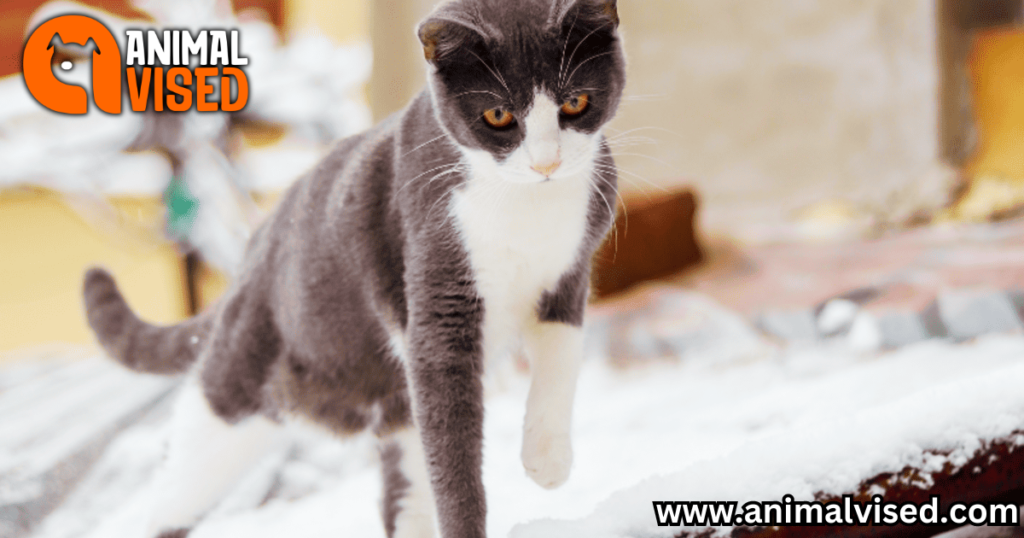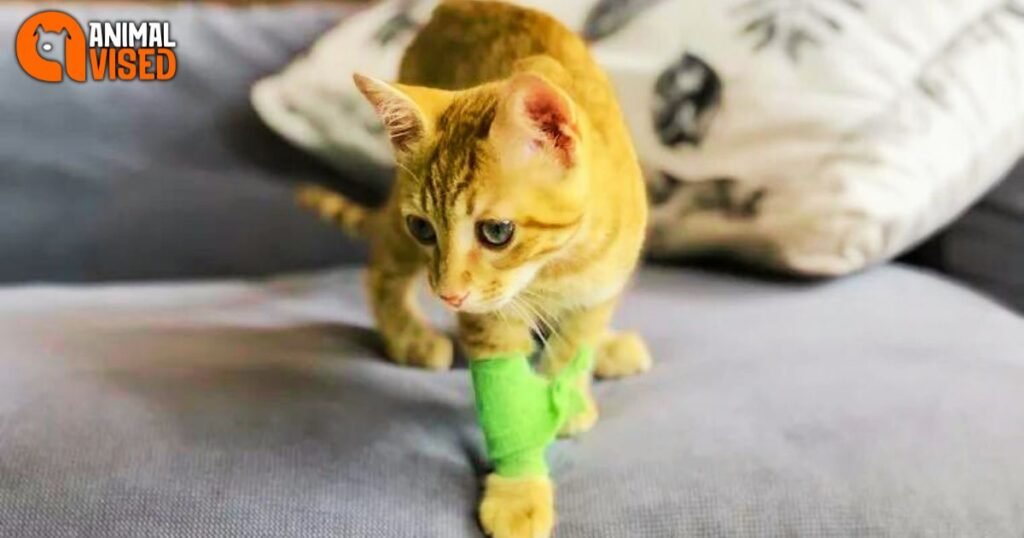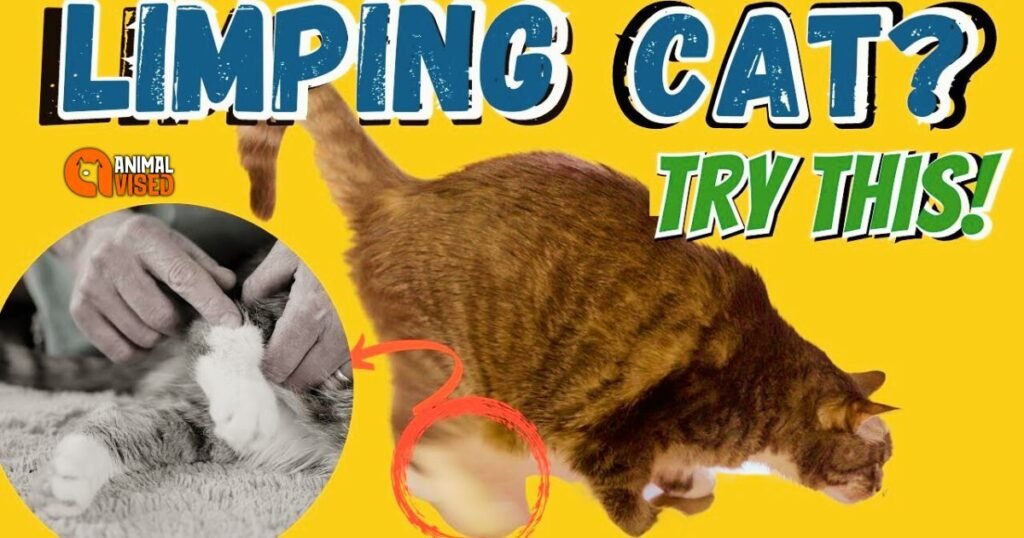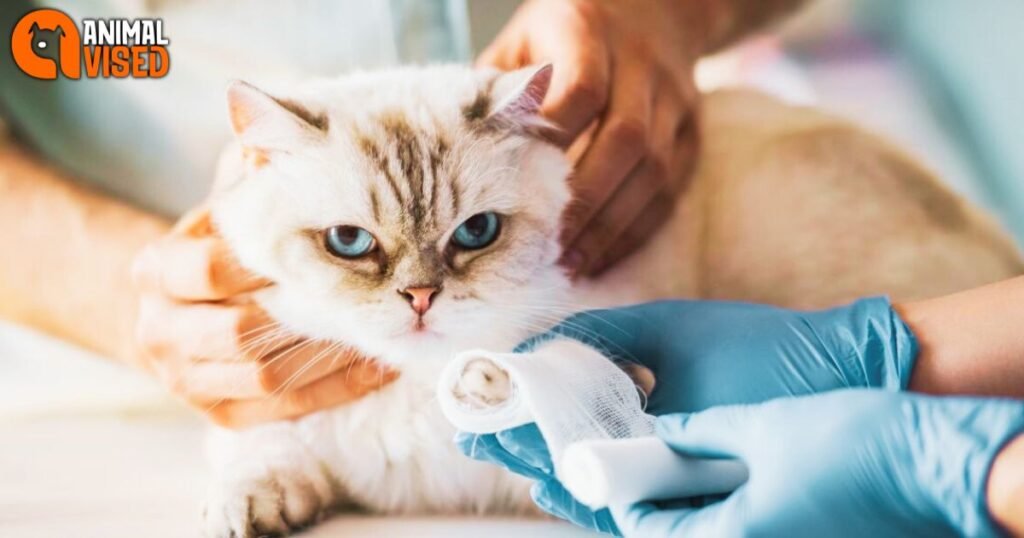Introduction:
As loving pet owners, we find it concerning to see our feline friends exhibiting signs of discomfort or pain. One of the most common indicators that something may be amiss is when a cat starts limping. A limping cat can be a symptom of various underlying issues, ranging from minor injuries to more serious medical conditions. In this comprehensive guide, we’ll explore the possible causes, treatment options, and essential steps to take when your furry companion develops a limp.
Read More: Cat Protect Making

My cat is limping but acting normal.
It’s not uncommon for cats to limp while still exhibiting relatively normal behavior in other aspects. This can make it challenging to determine the severity of the issue. Just because your cat is still eating, playing, and grooming themselves doesn’t necessarily mean the limp is insignificant. Cats are resilient creatures and have a high tolerance for pain, often masking their discomfort until the condition worsens.
If your cat is limping but acting normally, it’s crucial to observe its movements and behavior closely. Look for subtle signs of distress, such as favoring one leg, reluctance to jump or climb, decreased activity levels, or changes in litter box habits. Even a slight limp can indicate an underlying issue that requires attention.
Limping Cat: Causes, Treatments, and Home Care
A limping cat can be a cause for concern, but it’s important to stay calm and assess the situation. Limping can be caused by a variety of factors, some minor and some more serious. This article will provide information on the different causes of limping in cats, how to treat them, and some home care options. It will also answer frequently asked questions (FAQs) about limping cats.
My Cat is Limping But Acting Normal
If your cat is limping but otherwise seems normal – eating, playing, using the litter box – it’s possible the limp is caused by a minor injury like a sprain or a small cut on their paw. However, it’s still important to monitor your cat closely and watch for any worsening symptoms.
Here Limping Cat are some signs to watch for:
- Increased limping
- Swelling or redness around the paw
- Difficulty putting weight on the leg
- Licking or chewing at the paw
- Loss of appetite or lethargy
If you notice any of these signs, it’s best to take your cat to the veterinarian for a checkup.
How to Treat a Limping Cat
The treatment for a limping cat will depend on the cause of the limp. Here are some common causes and their remedies:
- Sprain or strain: Rest is typically the best treatment for a sprain or strain. Your veterinarian may also recommend anti-inflammatory medication to help reduce pain and swelling.
- Wound or puncture: Wounds and punctures need to be cleaned and treated with antibiotics to prevent infection. Your veterinarian may also prescribe pain medication.
- Arthritis: There is no cure for arthritis, but there are treatments that can help manage the pain and inflammation. These include medications, supplements, and weight management.
- Fracture: A veterinarian will need to set a fractured bone. Depending on the severity of the fracture, your cat may need to be placed in a cast or splint.
- Abscess: An abscess is a collection of pus that forms under the skin. A veterinarian must lance and drain the abscess. Antibiotics may also be prescribed.
It’s important to never give your cat any medications without first consulting your veterinarian.

My Limping Cat But Still Jumping and Running
Even if your cat seems relatively unaffected by their limp and is still jumping and running, it’s important to take them to the veterinarian. Ignoring a limp could lead to a more serious injury if the underlying cause is not addressed.
Cat Suddenly Limping Back Leg
A sudden limp in a back leg could be caused by a sprain, strain, wound, or even a pinched nerve. It’s important to take your cat to the veterinarian for diagnosis and treatment.
My Cat is Limping But Not Crying
Just because your cat isn’t crying in pain doesn’t mean they’re not uncomfortable. Cats are good at hiding pain, so it’s important to be observant of any changes in their behavior, such as limping, licking the paw, or being less active.
Can a Limping Cat Heal Itself?
In some cases, a minor limp may heal on its own with rest. However, it’s always best to err on the side of caution and take your cat to the veterinarian for a checkup. This will help to ensure that there is no underlying cause for the limp that needs to be addressed.
Limping Cat Symptoms
In addition to limping, there are a number of other symptoms that may accompany a limp in cats. These include:
- Swelling or redness around the paw
- Difficulty putting weight on the leg
- Licking or chewing at the paw
- Loss of appetite or lethargy
- Fever
- Vocalization (crying or yowling) in pain
If you notice any of these symptoms in your cat, it’s important to take them to the veterinarian right away.
Limping Cat Home Remedy
There are no safe or effective home remedies for a limping cat. If you suspect your cat has a limp, the best course of action is to take it to the veterinarian for a diagnosis and treatment.
Here are some things you can do at home to help your limping cat:
- Rest: Allow your cat to rest comfortably. Avoid strenuous activity or playtime.
- Warm compress: Apply a warm compress to the affected area for a few minutes at a time, several times a day. This can help to reduce pain and inflammation.
- Comfortable bedding: Provide your cat with soft, comfy bedding to rest on.
It’s important to never give your cat any medications without first consulting your veterinarian.
How to treat a limping cat
The appropriate treatment for a limping cat depends on the underlying cause. Here are some common steps to consider:
- Examine the affected limb: Gently inspect the limb for any visible signs of injury, swelling, or abnormalities. Be cautious, as your cat may react defensively if you touch a sensitive area.
- Restrict activity: Limit your cat’s movement and provide a comfortable, quiet space for rest. This will prevent further aggravation of the injury or condition.
- Apply cold therapy: If there is swelling or inflammation, you can apply a cold pack wrapped in a towel to the affected area for 10-15 minutes, several times a day. This can help reduce pain and swelling.
- Administer pain medication: If your cat is in visible discomfort, consult your veterinarian about administering safe pain medication. Never give your cat human medication without professional guidance.
- Seek veterinary attention: If the limp persists for more than a day or two or if you notice any concerning symptoms (such as lethargy, loss of appetite, or difficulty urinating/defecating), schedule an appointment with your veterinarian. They will likely perform a physical examination, take X-rays, or recommend additional diagnostic tests to identify the underlying cause and provide appropriate treatment.

My cat is limping but still jumping and running.
While it may seem counterintuitive, it’s not uncommon for Cats to continue jumping and running despite limping. This behavior is often a result of their innate survival instincts and their desire to appear strong and unaffected by pain or injury.
However, just because your cat is still jumping and running doesn’t mean the limp should be ignored. These activities can exacerbate the underlying condition and delay the healing process. It’s essential to monitor your cat’s movements closely and take appropriate action to prevent further injury.
If your cat is limping but still jumping and running, consider the following steps:
- Restrict access: Your cat should be limited in areas that encourage jumping or running, such as high shelves, countertops, or staircases.
- Provide low-stress environments: Create a calm, quiet space for your cat to rest and recover, away from distractions or triggers that may encourage excessive activity.
- Use deterrents: Employ deterrents like double-sided tape, aluminum foil, or citrus scents on surfaces where you don’t want your cat to jump or run.
- Consider confinement: In more severe cases, your veterinarian may recommend temporarily confining your cat to a small, comfortable space to restrict movement and promote healing.
Remember, while your cat’s desire to maintain their normal activities may seem impressive, it’s essential to prioritize their health and well-being by taking appropriate measures to prevent further injury or complications.
cat suddenly limping back leg
A sudden onset of limping, particularly in the back leg, can be a cause for concern. This abrupt change in your cat’s gait may indicate an acute injury or an underlying condition that requires prompt attention. Here are some potential causes and recommended actions:
- Trauma or injury: Your cat may have experienced a fall, been stepped on, or sustained an injury while playing or jumping. Inspect the affected leg for signs of swelling, bruising, or abnormalities.
- Muscle strain or sprain: Sudden movements or awkward landings can lead to muscle strains or sprains in the back leg. These injuries may cause pain and limping.
- Joint issues: Conditions like arthritis, hip dysplasia, or other joint problems can manifest as sudden limping in the back leg. These issues are more common in older cats or those with a history of joint problems.
- Nerve damage: Injuries or compressions to the nerves supplying the back leg can result in sudden limping or weakness.
- Foreign object: In some cases, a foreign object (such as a thorn or splinter) may become lodged in the paw or leg, causing discomfort and limping.
Suppose your cat suddenly starts limping on their back leg. In that case, it’s essential to schedule a veterinary appointment as soon as possible. Your veterinarian will perform a thorough examination, possibly including X-rays or other diagnostic tests, to determine the underlying cause and provide appropriate treatment.
In the meantime, restrict your cat’s activity, provide a comfortable resting area, and avoid trying to manipulate or examine the affected leg yourself, as this may cause further discomfort or injury.
My cat is limping but not crying.
Cats are known for their stoic nature and high pain tolerance, which can make it challenging to determine the severity of their condition. If your cat is limping but not crying or vocalizing distress, it doesn’t necessarily mean the issue is minor.
Several factors can contribute to a cat’s lack of vocalization when in pain or discomfort:

- Survival instincts: In the wild, showing signs of weakness or vulnerability can make cats easy targets for predators. This instinct may carry over into domestic settings, causing them to mask their pain.
- Tolerance to pain: Cats have a higher tolerance for pain compared to other Animals, including humans. This evolutionary trait helps them survive in harsh environments.
- Personality traits: Some cats are simply more vocal than others, and their willingness to vocalize discomfort can vary based on their personalities.
While a lack of crying or vocalizing distress may seem reassuring, it’s essential not to disregard the limping behavior. Persistent limping can indicate an underlying issue that requires veterinary attention.
If your cat is limping but not crying, closely monitor their behavior for other subtle signs of discomfort, such as:
- Reduced appetite or water intake
- Changes in litter box habits
- Excessive grooming or licking of the affected area
- Lethargy or reluctance to move
- Aggression or avoidance when the affected area is touched
If any of these additional symptoms are present, or if the limping persists for more than a day or two, it’s advisable to schedule a veterinary appointment for a proper examination and diagnosis.
Can a limping cat heal itself?
In some cases, a limping cat may heal itself without veterinary intervention, particularly if the underlying cause is minor or temporary. However, it’s essential to understand that not all limping conditions can resolve on their own, and waiting too long for self-healing can potentially worsen the issue or lead to long-term complications.
Here are some scenarios where a limping cat may heal itself:
- Minor sprains or strains: If your cat has sustained a minor sprain or strain due to overexertion or an awkward landing, rest and limited activity may allow the affected area to heal naturally.
- Temporary muscle soreness: Cats, particularly active ones, can occasionally experience muscle soreness or stiffness, which may manifest as a temporary limp. With rest and time, the soreness may subside, and the limp should resolve.
- Mild bruising or contusions: Minor bruises or contusions from bumps or falls can cause temporary limping. As the bruising subsides, the limp may improve on its own.
However, veterinary intervention is often recommended for a limping cat, especially if the limp persists for more than a day or two or is accompanied by other concerning symptoms. Conditions like fractures, joint issues, nerve damage, or underlying medical problems are unlikely to resolve without proper treatment.
It’s important to monitor your cat’s progress closely and seek professional advice if there is no improvement or if the condition seems to worsen. Delaying treatment can not only prolong your cat’s discomfort but also increase the risk of complications or permanent damage.
Limping cat symptoms
While limping is the most obvious symptom that something is amiss with your feline friend, several other signs and symptoms may accompany a limping cat. Being aware of these additional indicators can help you better assess the severity of the situation and determine the appropriate course of action.

Common symptoms associated with a limping cat include:
- Swelling or bruising: Visible swelling or bruising around the affected limb or joint can indicate an injury, such as a sprain, fracture, or contusion.
- Reluctance to bear weight: Your cat may avoid putting weight on the affected limb or holding it off the ground entirely.
- Lethargy or decreased activity: Pain or discomfort can cause your cat to become less active and passive, preferring to rest or sleep more than usual.
- Decreased appetite or water intake: Cats in pain or discomfort may experience a decreased appetite or reduced water intake.
- Changes in litter box habits: Limping or mobility issues can make it challenging for your cat to access or use the litter box properly, leading to accidents or avoidance.
- Excessive grooming or licking: Your cat may excessively groom or lick the affected area, potentially indicating pain or discomfort.
- Irritability or aggression: Pain can cause some cats to become irritable, aggressive, or defensive, especially when the affected area is touched or handled.
- Muscle atrophy: In cases of prolonged limping or immobility, muscle atrophy (wasting) may occur in the affected limb due to lack of use.
- Fever or lethargy: In cases of infection or systemic illness, your cat may exhibit signs of fever, lethargy, or general malaise.
It’s important to note that the presence of additional symptoms can help your veterinarian determine the underlying cause of the limping and provide appropriate treatment. If you notice any concerning symptoms accompanying your cat’s limp, seek veterinary attention promptly.
Limping cat home remedy
While professional veterinary care is always recommended for a limping cat, some home remedies can provide temporary relief and support your cat’s healing process. However, it’s crucial to understand that these remedies should not replace proper medical treatment, especially if the limp persists or worsens.
Here are some safe and effective home remedies for a limping cat:
- Rest and confinement: Limiting your cat’s activity and providing a quiet, comfortable space for rest can help prevent further injury and promote healing. Confine your cat in a small room or crate with their litter box, food, and water to restrict movement.
- Cold therapy: Applying a cold compress or ice pack wrapped in a towel to the affected area for 10-15 minutes several times a day can help reduce swelling and inflammation.
- Warm compresses: For chronic or arthritic conditions, applying a warm compress to the affected area can help increase blood flow and alleviate stiffness and discomfort.
- Gentle massage: Gently massaging the affected limb or area can improve circulation and provide temporary relief. However, be cautious and stop if your cat shows signs of discomfort or aggression.
- Supportive bandaging: If your cat has sustained a sprain or minor injury, carefully wrapping the affected area with a soft, supportive bandage can provide stability and protection during the healing process. Ensure the bandage is not too tight and change it regularly.
- Dietary supplements: Certain supplements, such as glucosamine and chondroitin, may help support joint health and reduce inflammation. However, consult your veterinarian before introducing any supplements to your cat’s diet.
- Pain relief medication: Over-the-counter pain relief medications, like aspirin or ibuprofen, should never be given to cats without veterinary supervision, as they can be toxic and cause serious side effects.
It’s important to remember that while these home remedies can provide temporary relief, they do not replace proper veterinary care. If your cat’s limp persists for more than a day or two or if you notice any concerning symptoms, you must schedule an appointment with your veterinarian for a proper diagnosis and treatment plan.

Conclusion:
Witnessing your beloved feline companion limp can be a heart-wrenching experience for any pet owner. While the sight of your cat favoring one leg or exhibiting signs of discomfort is undoubtedly concerning, it’s essential to approach the situation calmly and informally.
Throughout this comprehensive guide, we’ve explored the various potential causes of Limping Cat, from minor injuries and strains to more serious underlying conditions. We’ve also delved into the importance of recognizing accompanying symptoms, seeking prompt veterinary attention when necessary, and implementing appropriate home remedies and care strategies.
Read More: Limping Cat
FAQs:
How can I tell if my cat’s limp is serious?
Suppose the limp is accompanied by swelling, bruising, lethargy, loss of appetite, or other concerning symptoms. In that case, it may indicate a more serious condition that requires prompt veterinary attention. Additionally, if the limp persists for more than a day or two without improvement, it’s best to seek professional advice.
Can I give my cat human pain medication for their limp?
No, it’s never recommended to give your cat human pain medication without veterinary guidance. Many common over-the-counter pain relievers, such as ibuprofen and acetaminophen, can be toxic and potentially fatal for cats.
How long does it typically take for a limping cat to heal?
The healing time can vary depending on the underlying cause and severity of the condition. Minor sprains or strains may heal within a week or two with proper rest and care. At the same time, more serious injuries or conditions may require several weeks or even months of treatment and recovery.
Can I bathe my limping cat or apply ointments to the affected area?
It’s generally not recommended to bathe or apply ointments or creams to a limping cat without veterinary guidance. These actions may cause further discomfort or complications, particularly if the underlying cause is unknown.
Should I restrict my cat’s movement if they are limping?
Yes, it’s advisable to restrict your cat’s movement and provide a quiet, comfortable space for rest and recovery. This can help prevent further injury and allow the affected area to heal properly.
Can a limping cat lead to other health problems if left untreated? Neglecting to address a persistent limp in your cat can potentially lead to other health issues. Compensating for the injured limb can cause muscle strains, joint problems, or even behavioral issues due to discomfort or pain.
How can I make my limping cat more comfortable at home?
Providing a soft, low-stress environment with easy access to food, water, and litter boxes can help. Additionally, using pet ramps or steps to minimize jumping and providing supportive bedding can alleviate pressure on the affected area.
Is it normal for a limping cat to experience mood changes or aggression?
Yes, it’s not uncommon for cats in pain or discomfort to exhibit mood changes, increased irritability, or even aggression. This can be their way of communicating their discomfort or protecting the affected area from further harm.
Can a limping cat be a sign of a more serious underlying condition?
In some cases, a persistent limp can be a symptom of an underlying medical condition, such as arthritis, hip dysplasia, nerve damage, or even certain types of cancer. Suppose the limp doesn’t improve with rest and care. In that case, it’s essential to have your veterinarian perform a thorough examination to rule out any serious health issues.
When should I seek emergency veterinary care for a limping cat?
Suppose your cat is limping and exhibiting signs of severe pain, trauma (such as a dangling limb or bleeding), lethargy, or other concerning symptoms. In that case, it’s important to seek emergency veterinary care immediately. Prompt treatment can prevent further injury and ensure your cat receives the appropriate care.










